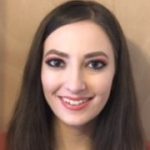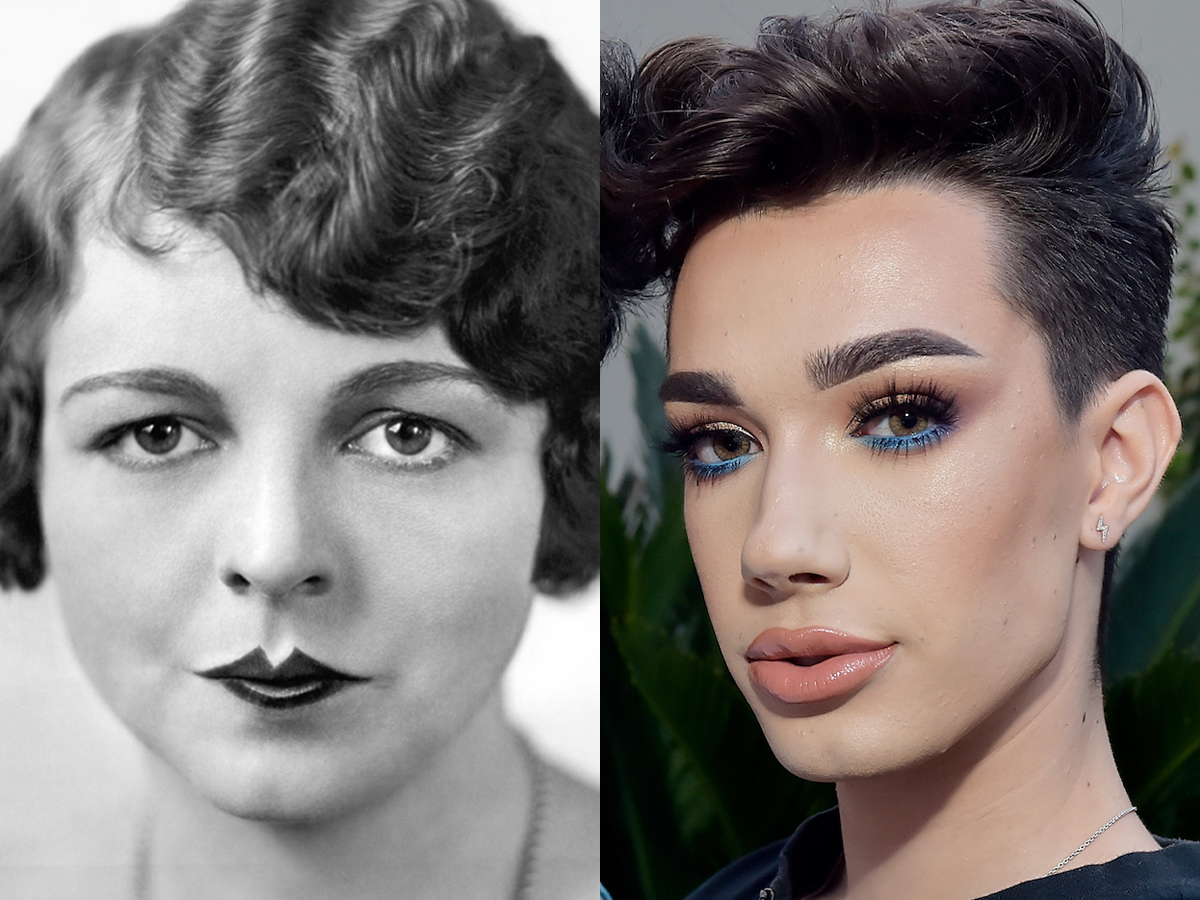- One hundred years ago in 1919, the ideal face of makeup was inspired by Hollywood, and was most commonly seen on movie stars.
- By the ’40s and ’50s, everyone was wearing red lipstick, as well as other beauty products that complimented their natural features.
- Throughout most of the 1900s, beauty products were created solely for women with light complexions. But in the ’70s, an influx of new cosmetic brands brought darker shades to the market.
- Beauty standards changed frequently between the ’70s and ’90s. Some women stopped wearing makeup altogether, while others wore bright colors daily.
- Today, the ideal face of makeup is often meant to evoke glamour, and is inspired by artists on YouTube and Instagram.
- Visit INSIDER’s homepage for more stories.
Just as fashion trends come and go, makeup fads are constantly evolving. And over the past 100 years, society has changed its notion of what the ideal face of makeup looks like.
In the early 1900s, for example, lips were the focal point of the face, and were often lined in sharp shapes. But by the 1950s, it became more common for women to wear rounded pouts in bright-red shades. Similarly, popular eye makeup has changed drastically; minimal colors were worn in the ’30s, and pastel eye shadow was popular in the ’80s.
From the early 1900s through to 2019, here’s a look back at what the ideal face of makeup has looked like over the past 100 years.
One hundred years ago in 1919, the ideal face of makeup was inspired by Hollywood.

Makeup was worn almost exclusively by movie stars and musicians between 1900 and 1919, according to Vintage Makeup Guide, a sister-blog of GlamourDaze that documents the history of early cosmetics.
But despite there being limited consumers at the time, some major advancements were made in the cosmetics industry. Max Factor founded his own beauty lab in 1909 to create products for the stars, and the first metal-tube of lipstick was invented in 1915.
Both developments impacted society's favored makeup looks in the early 1900s. Throughout the decade, women who wore makeup preferred pale, powdered skin, as well as stained lips.
By the 1920s, lips became the focal point of all beauty looks.

Because complexion products were still largely associated with movie stars at the time, items like face powder and cream-rouge compacts were popular.
The products helped women to look natural while also mirroring the Hollywood style of the time, according to Vintage Dancer, a style website and online store created by author Debbie Sessions, who researches the history of fashion.
But women did take some liberties, especially with their lips. The ideal face of makeup in the '20s was never complete without red lipstick, which was often applied in a rounded shape on the bottom lip, and sharply on the top to accentuate the cupid's bow.
The ideal face of makeup in the 1930s typically included thin eyebrows and slim eyelashes.

According to a Vintage Dancer interview with Gabriela Hernandez, the founder of vintage beauty brand Besame Cosmetics, less was more in the 1930s. Even from the base, the ideal face of makeup at the time started with powdered skin and minimal rouge.
From there, women typically applied petroleum jelly or olive oil to their eyelids to create a glossy effect, and then enhanced their eyelashes with dark henna. Still, they avoided making their lashes too thick.
To tie everything together, women commonly plucked their eyebrows into slim shapes with a high arch and winged-out edges. Some women even shaved their eyebrows entirely, and drew thin lines with a pencil.
World War II largely impacted standard makeup looks of the 1940s.

According to Millihelen, a beauty blog previously run by Jezebel, cosmetics in the '40s were often difficult to get hold of due to war rationing, and were taxed heavily in a number of countries as a luxury item. And yet, women were still expected to wear makeup.
Lip products in particular were favored by government officials, as they were considered to be a morale booster for women living during the war. As a result, the ideal face of makeup in the 1940s was nothing without red lipstick.
However, the rest of the face generally wasn't as bold. Eyebrows were often shaped into a rounded arch, and eye shadow and blush were worn sparingly.
In the 1950s, women commonly wore thick foundation, bold lip colors, and rosy blush.

Women aimed to look glamorous in the '50s, and piled on heavy products to achieve a flawless look, according to GlamourDaze. For example, people commonly wore cream foundations underneath powder.
Women were also known to apply light rouge to the apples of their cheeks, and add a small wing to the edge of their eyeliner. Mascara was also popular, though it was typically only applied to the upper eyelashes.
Eye makeup was the center of all beauty looks in the 1960s.

From the early 1900s until the 1950s, popular makeup focused on the face, particularly the lips, cheeks, and eyebrows. But in the '60s, according to Millihelen, eye makeup took center stage.
The ideal face of makeup at the time consisted of opaque eye shadow in pastel shades. Some women covered their eyelids with color, while others applied shadow using a technique called a cut crease, which is still popular today.
To create a cut-crease look in the '60s, one would use pastel eye shadow or eyeliner to draw a distinct line across the crease of their eyelid. The look was typically paired with winged black eyeliner, and completed with more eyeliner on the lower lash line.
Many women preferred not to wear makeup in the 1970s.

It can be difficult to determine what the ideal face of makeup looked like during the '70s. Some women were still donning '60s trends, according to the Hair and Makeup Artist Handbook, while others favored disco styles. A select group was even experimenting with punk fashion at the time.
However, many women in the '70s participated in the women's liberation movement, and commonly rejected beauty stereotypes. To fight back at the sexism they often faced, those who wore makeup aimed to look natural.
Cosmetic brands also took notice of the trend, and began introducing products labeled "'barely there" and "invisible." Glowing skin was desired, according to Good Housekeeping, and eye makeup was practically nonexistent, aside from light mascara, according to Elle.
The ideal face of makeup also became more inclusive in the '70s.

Throughout most of the 1900s, beauty products were created solely for women with light complexions. But in the '70s, an influx of new cosmetic brands brought darker shades to the market.
According to Racked, a lawyer and chemist named Anthony Overton was the first to create beauty products for black women in 1898. New brands continued to emerge in following decades, though they were often known for selling makeup that promised to lighten the skin.
But in the late '70s, cosmetics for black women became more accessible at makeup counters. A 1977 article from The Washington Post said the industry was worth $1.5 billion at the time, and was then growing between 15% and 20% per year.
And by 1978, Barbara Walden Cosmetics had created a first-of-its-kind beauty line specifically for black women that was sold in stores around the country, such as Macy's.
Throughout the 1980s, popular makeup was all about bright colors.

Just as fashion was bright and colorful in the 1980s, so was the ideal face of makeup. Pink, purple, and blue eye shadows were particularly popular, according to Cosmopolitan, and pink blush was worn heavily across the cheeks.
Eyeliner also played a big role in '80s makeup trends, according to Like Totally '80s, a blog that documents the decade. Those who wore eyeliner applied the product in thick layers around their eyes, and sometimes used the product to draw fake beauty spots, likely to imitate Madonna.
In the 1990s, the ideal face of makeup was all about shine and sparkle.

According to Bustle, the '90s saw a resurgence of some beauty trends from past decades, like thin eyebrows and blue eye shadow. However, there were some new innovations that changed the ideal face of makeup during the decade.
Shimmering lips, for example, were all the rage throughout the '90s. To achieve maximum shine, women would often wear a shiny gloss over a frosted lipstick. Some of the most popular colors at the time were deep browns and reds, according to Cosmopolitan.
It was also common to wear rhinestones across your face, such as above your eyebrows or across your cheeks, and glitter gel across your shoulders and neck.
Read more: Sephora is selling makeup that looks like school supplies, and it'll bring you back to the '90s
Bright blush and lip gloss helped to create optimal makeup looks in the early 2000s.

While women used a variety of lip products to achieve high-shine looks, Elle Australia credits the early-2000s trend to the popularity of Lancôme Juicy Tube lip glosses at the time.
An ideal face of makeup in the early 2000s was also commonly completed with heavy eyeliner and bright blush, according to Cosmopolitan.
By 2010, everyone was wearing smoky eye makeup.

While the ideal face of makeup at the time was rather simple, eye makeup was anything but. Broadly credits this trend to Kim Kardashian West, who often sported thick eyeliner and smoky eye shadow in the earliest seasons of "Keeping Up With the Kardashians."
The look was made even more popular as a result of stars like Snooki and Jenni "Jwoww" Farley wearing it in the earliest episodes of "Jersey Shore."
But the ideal face of makeup didn't just apply to women. In the 2010s, more men started wearing makeup.

At the time, men also sported smoky eye looks, especially male musicians. Of course, this trend didn't start in 2010. Stars such as Little Richard, Mick Jagger, Prince, and David Bowie had all worn eyeliner decades before, between the '50s and '80s, as Billboard points out.
However, musicians like Jared Leto, Pete Wentz, Gerard Way, and Brandon Flowers helped bring the trend back to life, and shifted society's perception of beauty throughout the decade.
Today, the ideal face of makeup is largely affected by trends on Instagram and YouTube.

The most popular modern beauty looks typically consist of perfectly-constructed eyebrows, deep contours, and bright highlight across the face, according to The New York Times. However, these trends are constantly shifting as a result of beauty vloggers on social media.
- Read more:
- The most head-turning celebrity hair and makeup looks at Coachella 2019
- I tried all 14 products in Urban Decay's 'Game of Thrones' makeup collection, and found it's so much more than a collector's item
- A woman says her $18 liquid lipstick held up after getting into a car accident, and people are loving her unconventional makeup review
- You can now buy a cheeseburger eye-shadow palette that looks good enough to eat

